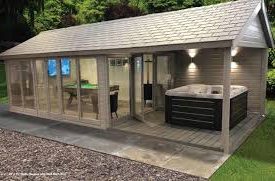A hot tub can be a wonderful addition to your backyard, providing a relaxing and therapeutic space for you and your family. However, it’s important to protect your investment by building a hot tub shed to keep it safe from the elements and prolong its lifespan. Here’s the ultimate guide to building a hot tub shed:
Planning
Before you start building your hot tub shed, you need to plan out the design and size of the shed. Consider the size of your hot tub, the number of people who will be using it, and the amount of space you have in your backyard. You’ll also need to consider the location of the shed and the direction of the sun, to ensure that you get maximum sunlight and heat.
Materials
The materials you choose for your hot tub shed will determine the durability and longevity of the shed. You’ll need to choose materials that are resistant to moisture, rot, and insects. Cedar, redwood, and pressure-treated lumber are popular choices for hot tub sheds due to their durability and resistance to decay.
Foundation
The foundation of your hot tub shed is crucial to its stability and longevity. The foundation should be level and able to support the weight of the hot tub and the shed. Concrete slabs or pavers are commonly used for hot tub shed foundations due to their stability and durability.
Walls
The walls of your hot tub shed should be sturdy and able to withstand the elements. The walls should be at least 8 feet tall to provide adequate ventilation and to prevent mold and mildew buildup. You can choose to use pre-built wall panels or build the walls yourself using lumber and sheathing.
Roof
The roof of your hot tub shed should be designed to protect the hot tub from rain, snow, and sun. You can choose from a variety of roofing materials, such as asphalt shingles, metal roofing, or corrugated polycarbonate panels. The roof should have a slope to prevent water from pooling on the surface and to encourage runoff.
Doors and Windows
The doors and windows of your hot tub shed should be weather-resistant and provide adequate ventilation. You can choose to use pre-built doors and windows or build them yourself using lumber and glass. Consider adding a skylight or clerestory windows to provide additional natural light.
Electrical Wiring
If you plan to install electrical wiring in your hot tub shed, it’s important to hire a licensed electrician to ensure that the wiring is up to code and safe. You’ll need to install a ground fault circuit interrupter (GFCI) to prevent electrical shocks and ensure that your hot tub is safely connected to the power source.
Ventilation
Proper ventilation is crucial for the safety and longevity of your hot tub shed. You’ll need to install vents to provide fresh air and prevent mold and mildew buildup. Consider installing a fan or dehumidifier to help regulate the humidity levels in the shed.
Finishing Touches
Once the construction of your hot tub shed is complete, it’s time to add the finishing touches. You can paint or stain the exterior of the shed to match your home’s exterior or to create a unique look. Consider adding landscaping around the shed to create a more inviting and attractive space.
In conclusion, building a hot tub shed can be a great way to protect your investment and create a relaxing and therapeutic space in your backyard. With careful planning, sturdy materials, and proper ventilation, you can build a hot tub shed that will provide years of enjoyment and relaxation for you and your family.

